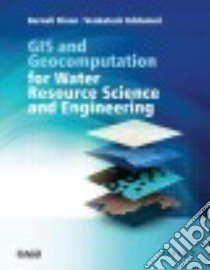Gis and Geocomputation for Water Resource Science and Engineering - 9781118354148
Un libro in lingua di Barnali Dixon Venkatesh Uddameri Chittaranjan Ray edito da Amer Geophysical Union, 2016
- € 155.20
- Il prezzo è variabile in funzione del cambio della valuta d’origine
The purpose of this book is to bridge the gap between the fundamentals of GIS and applications of this technology to the practice of environmental engineering and science. Students are provided a complete picture of GIS including data availability and fundamental spatial analysis techniques using hands-on environmental applications. A series of case-studies are used to demonstrate how GIS can enhance environmental science and engineering design and analysis. This combination of active GIS learning supplemented with case-study based reinforcement helps the student (and the practitioner) not only understand the fundamental concepts but also see how they can be used in real-world applications.
This book will encompass a broad range of topics that will comprehensively cover both the fundamental and applied aspects of geographic information systems (GIS), with a specific focus on environmental and water resources applications. By providing a focus on coupling GIS with other innovative information-theoretic tools such as fuzzy logic, neural networks and support vector machines the book will demonstrate how these GIS technologies can be used to harness increasingly available digital data to develop spatially-oriented sustainable solutions.
This textbook aims to:
(i) Introduce foundations of spatial analysis including raster and vector representations and relational databases.
(ii) Integrate environmental modeling and GIS concepts.
(iii) Discuss benefits and challenges of environmental and water resources GIS applications, including a thorough discussion on estimation accuracy, precision, scaling and data consistency issues.
(iv) Demonstrate advanced GIS skills related to terrain and network analysis.
(v) Include a chapter on three dimensional visualization and integrating with remote-sensing data.
(vi) Combine environmental GIS applications with other information-theoretic approaches such as artificial neural networks and fuzzy logic.
A series of case-studies are used to demonstrate how GIS can enhance environmental science and engineering design and analysis. This combination of active GIS learning supplemented with case-study based reinforcement helps the student (and the practitioner) not only understand the fundamental concepts but also see how they can be used in real-world applications.
This proposed book package (including web-based materials) will include power-point lecture outlines; outlines for a potential syllabus (a semester-long) course at the undergraduate and graduate levels; data for applications and example exercises and software-based instructions for the case studies. This information should facilitate the hands-on learning approach to be adopted in the text.
The authors note..
If someone does not have access to GIS in the classroom (as in many developing nations) they can still learn the theory of GIS and its application through case studies for environmental and watershed modeling and management. This means students can be tested on the theory if they use this book as a text – yet they will have the opportunity to develop limited understanding of applications (despite the lack of software). The textbook will not emphasize a particular GIS software, so the examples and knowledge gained can be applied with any GIS software and there are a few free GIS software that students and faculty in developing countries can use along with the text. We will provide a list of free software (open source) (for GIS as well as AI tools – such as Fuzzy Logic, Neural Networks, Neuro-fuzzy and Support Vector Machines).
Informazioni bibliografiche
- Titolo del Libro in lingua: Gis and Geocomputation for Water Resource Science and Engineering
- Lingua: English
- Autori : Barnali Dixon Venkatesh Uddameri Chittaranjan Ray
- Editore: Amer Geophysical Union
- Collana: Amer Geophysical Union (Hardcover)
- Data di Pubblicazione: 08 Febbraio '16
- Genere: SCIENCE
- Argomenti : Watershed management Data processing Water resources development Data processing Geographic information systems Industrial applications
- Pagine: 832
- ISBN-10: 1118354141
- EAN-13: 9781118354148


